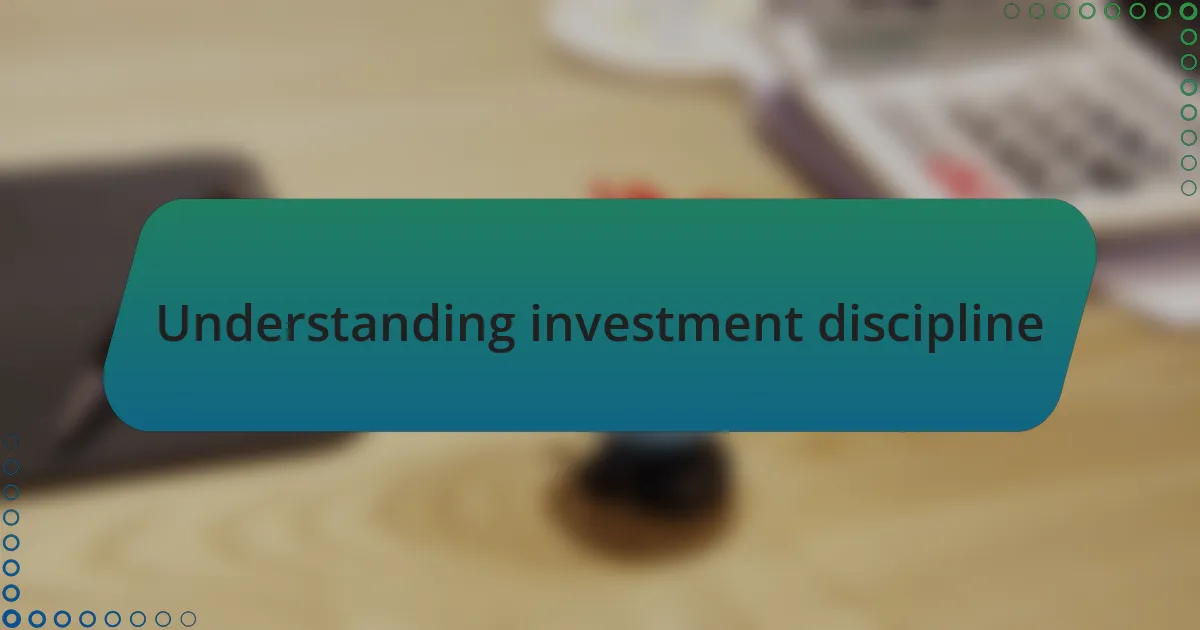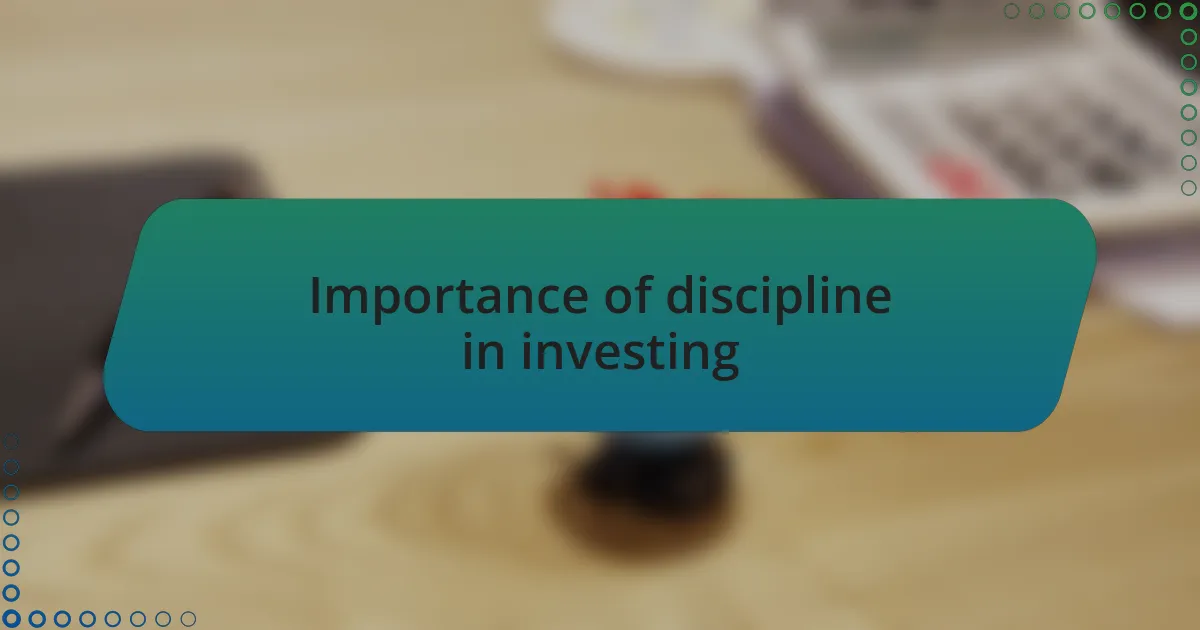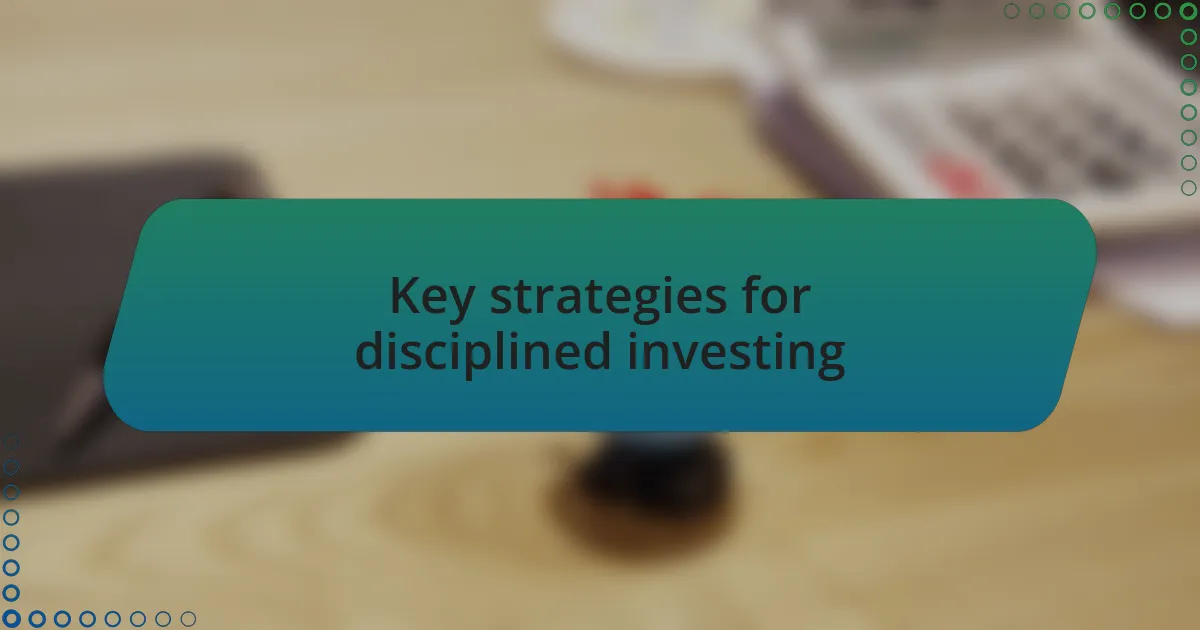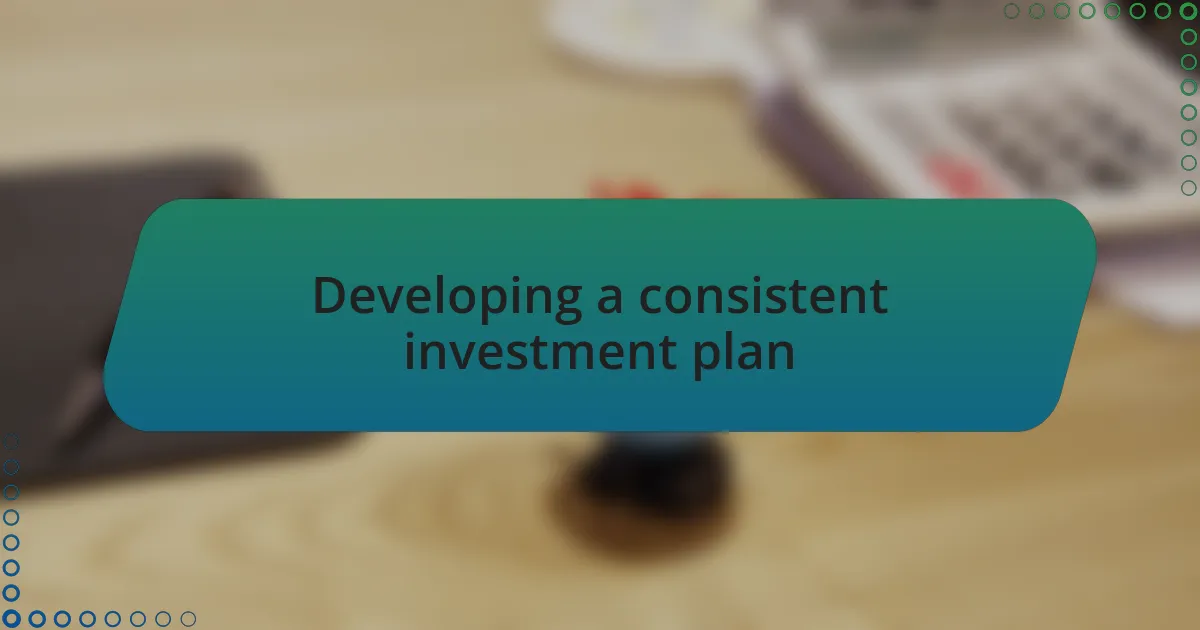Key takeaways:
- Investment discipline involves setting clear goals and adhering to a structured investment plan to withstand market fluctuations.
- Recognizing emotional triggers like fear and greed is crucial in making informed investment decisions.
- Regularly reviewing and adjusting investment plans according to personal goals and risk tolerance is essential for long-term success.
- Utilizing tools for tracking progress, such as investment apps and alerts, enhances motivation and allows for timely decision-making.

Understanding investment discipline
Investment discipline is about maintaining a consistent approach to investing, even in the face of market volatility. I remember a time when I panicked during a market dip, and it led to me making hasty decisions that I later regretted. Have you ever found yourself in a similar situation? The key is to set clear goals and stick to your strategy, allowing you to rise above the noise.
For me, discipline in investing means having a plan and following it diligently, regardless of what’s happening around me. I once decided to allocate a set percentage of my income toward investments every month. The automation of this process offered me peace of mind and kept my emotional impulses at bay. It’s fascinating how simple decisions can make a significant impact.
Understanding investment discipline also requires recognizing our emotional triggers. Fear and greed can distort our judgment. I often ask myself how I would feel a year from now about a decision I’m contemplating today. This reflection helps ground my choices and reinforces the importance of staying disciplined in the investment journey. Would your future self thank you for today’s choices?

Importance of discipline in investing
The importance of discipline in investing cannot be overstated. I recall a period when I strayed from my investment strategy, tempted by sensational headlines and social media buzz. In hindsight, I realized those distractions nearly derailed my long-term goals. Staying committed to my plan not only improved my outcomes but also provided me with a sense of stability amid the chaos. Have you felt a similar temptation?
Discipline acts as a safeguard against emotional pitfalls. During a market downturn, it’s easy to let fears take control. I’ve experienced moments when panic whispered in my ear, urging me to sell. Instead, I chose to remember my strategy and refused to be swayed by fear—this decision ultimately paid off. How do you handle such moments of doubt?
Moreover, a disciplined approach fosters patience, an essential trait for any investor. I’ve learned that investments often require time to blossom. Early on, I made the mistake of expecting immediate returns, and it taught me that consistency and perseverance are key. Reflecting on your journey, are you allowing sufficient time for your investments to mature? The answers we find in discipline can lead us to the investments that truly thrive.

Key strategies for disciplined investing
One effective strategy for maintaining discipline in investing is setting clear goals. I remember when I first defined my investment objectives; it felt like turning on a light switch in a dark room. Those goals served as my guiding stars, keeping me focused and away from dawdling on fleeting trends. Have you taken the time to outline what you want to achieve with your investments?
Another significant tactic is establishing a structured investment plan. Creating a detailed roadmap that includes asset allocation and periodic reviews has greatly enhanced my commitment. I once deviated from my plan during a particularly bullish market, only to face anxiety when corrections occurred. Returning to my pre-established structure alleviated that stress, making me wonder—what does your investment roadmap look like?
Lastly, I find it crucial to restrict my reactions to market fluctuations. In moments of market volatility, I remind myself of the larger picture, rather than fixating on daily changes. There was a time when every dip had me questioning my choices. Now I’ve learned that real discipline means sticking to my long-term strategy and not reacting impulsively. How do you manage your emotions in the face of market swings?

Setting and sticking to goals
Setting practical and achievable investment goals has been a game changer for me. I remember pacing back and forth with my first investment decisions, unsure of what I wanted to accomplish. Once I defined my goals—like saving for a home or retirement—it was as if I gained a clear vision. Goals give me a sense of direction; how do your goals guide your investment journey?
Sticking to my goals often requires constant reflection. A few years back, I found myself tempted by the latest tech stock hype. Instead of diving in, I took a moment to review my original objectives and realized that it didn’t align with my long-term plan. That moment of pause reminded me of the importance of discipline in staying true to my established aims. What strategies do you use to ensure you remain focused on your plan?
Another essential aspect is the timeline connected to my goals. Recently, I revisited a goal I had set for five years out. The review process revealed I was ahead of schedule, which felt incredibly rewarding. This check-in made me realize that periodically reassessing goals keeps me motivated and on track. Have you ever refreshed your investment timeline to see how far you’ve come?

Developing a consistent investment plan
Developing a consistent investment plan starts with a clear outline of what I want to achieve. When I first began investing, I used to change my strategy every few months based on market trends. However, I found that creating a detailed plan with specific allocations for different assets—like stocks, bonds, and real estate—helped me stay grounded. Have you ever thought about how having a structured approach could simplify your investing?
Another layer to my investment plan is the practice of regular reviews. Last year, I dedicated a weekend to analyze my portfolio thoroughly, which was an eye-opener. I discovered that while my investments were generally performing well, my risk tolerance had changed over time. This realization prompted me to adjust my plan accordingly, ensuring it still aligned with my current lifestyle and goals. How often do you pause to evaluate if your plan is still serving you?
Lastly, consistency in execution has been vital for me. I learned early on that dollar-cost averaging—investing a fixed amount regularly, regardless of market conditions—helped mitigate volatility. For instance, during a market downturn, my resolve was tested, but sticking to my plan allowed me to purchase more shares at lower prices. It reinforced my belief in the power of patience and discipline. What methods do you have in place to maintain consistent contributions to your investments?
![]()
Utilizing tools for tracking progress
Utilizing tools for tracking progress is a game changer in investment discipline. I started using investment apps to monitor my portfolio regularly, and it transformed how I view my financial journey. Seeing my investments grow in real-time not only kept me motivated but also served as a constant reminder of my long-term goals. Have you ever noticed how simply tracking your progress can boost your confidence?
Another essential tool I’ve incorporated is setting alerts. When I began investing, I often missed important shifts in market trends that impacted my portfolio. By setting price alerts and notifications, I can now react promptly and make informed decisions before the opportunity slips away. It’s fascinating how technology can empower us to take command of our investing strategies, don’t you think?
Lastly, I’ve found that visualizing my progress through graphs and reports makes a significant difference. Each month, I review my performance and compare it to my benchmarks. The satisfaction I get from seeing green bars on my charts reinforces my commitment and discipline. Tracking my progress visually allows me to celebrate small wins, which is crucial on this sometimes daunting investment path. How do you celebrate your achievements in investing?

Reflecting on personal investment experiences
Reflecting on my personal investment experiences has been a journey of growth and learning. I remember the early days when I jumped into investing with enthusiasm but lacked a strategic approach. The thrill of buying my first stock felt exhilarating, yet when it dipped shortly after, doubt crept in. Have you ever felt that initial excitement clash with uncertainty? It’s a feeling I believe many investors face.
Over time, I learned that perseverance is key. I recall a moment when I held onto a volatile investment despite the turmoil in the market. Friends advised me to sell, but my research suggested otherwise. Trusting my analysis proved rewarding when the market rebounded. Reflecting on that experience taught me the importance of maintaining a disciplined mindset, especially during turbulent times.
There were also lessons in recognizing my emotional triggers. I’ve had moments when fear clouded my judgment, prompting rash decisions that weren’t aligned with my strategy. One particular instance stands out: I ignored my well-thought-out plan and sold in a panic, only to watch the stock rise shortly after. Now, I make it a point to pause and evaluate my emotions before acting. How do you navigate your feelings when investing? For me, stopping to reflect has made all the difference.